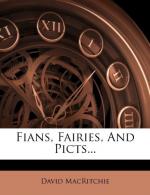[Footnote 18: “La legende des Pygmees et les nains de l’Afrique equatoriale”: Rev. Hist. t. 47, I. (Sept.-Oct. 1891), pp. 1-64.]
[Footnote 19: For some of these references see Dr. Hibbert’s “Description of the Shetland Islands,” Edinburgh, 1822, pp. 444-451. See also Mrs. J.E. Saxby’s “Folk-Lore from Unst, Shetland” (in Leisure Hour of 1880); Mr. W.G. Black’s “Heligoland”, 1888, chap. iv.; and “The Fians,” London, 1891, pp. 2-3.]
[Footnote 20: Gwynn the son of Nudd: for whom see Lady C. Guest’s “Mabinogion,” pp. 223, 263-5, and 501-2.]
[Footnote 21: “The War of the Gaedhil with the Gaill,” edited by J.H. Todd, D.D., London, 1867, pp. 114-115.]
[Footnote 22: I. cc. 4-6 (this reference and the passage is quoted from Du Chaillu’s “Viking Age,” vol. ii. p. 516).]
[Footnote 23: “Fianaibh ag Sithcuiraibh”]
[Footnote 24: “Dan an Fhir Shicair”; Leabhar na Feinne, pp. 94-95.]
[Footnote 25: Folk-Lore Journal, vol. vi. 1888, pp. 173-178.]
[Footnote 26: The Fians, 1891, p. 64.]
[Footnote 27: Ibid. p. 33.]
[Footnote 28: The Fians, p. 172. The Fairy Hill referred to is “a hillock, in which there is to be seen a small hollow called the armoury” (p. 174).]
[Footnote 29: Ibid. pp. 12-13, 166, &c.]
[Footnote 30: Ibid. pp. 3-4. Glenorchy is said to have teemed with Fenian traditions about the early part of this century (Proceedings of Soc. of Antiq. of Scotland, vol. vii. pp. 237-240).]
[Footnote 31: See my Testimony of Tradition, London, 1890, pp. 146-8; and Pennant’s “Second Tour in Scotland” (Pinkerton’s Voyages, London, 1809, vol. iii. p. 368).]
[Footnote 32: Proceedings of Society of Antiquaries of Scotland, vol. vii. p. 294, note.]
[Footnote 33: See, for example, an article on “Scottish Customs and Folk lore,” in The Glasgow Herald of August 1, 1891.]
[Footnote 34: The Fians, pp. 78-80.]
[Footnote 35: Scottish Celtic Review, 1885, pp. 184-90: The Fians, pp. 175-184.]
[Footnote 36: The Heimskringla: Dr. Rasmus B. Anderson’s 2nd ed. (1889) of Mr. Samuel Laing’s translation from Snorre Sturlason: chap. lxxxiii., Of Little Fin.]




